XenDesktop 7 on Windows Azure Design Guide
XenDesktop 7 on
Windows Azure
citrix.com
�
XenDesktop 7 on Windows Azure Design Guide
About this
design guide
The Citrix Design Guide provides
an overview of the XenDesktop 7
on Azure solution architecture and
implementation. This design has
been created through architectural
design best practices obtained
from Citrix Consulting Services
and thorough lab testing, and
is intended to provide guidance
for solution evaluation and the
introduction of proof of concepts.
The Design Guide incorporates
generally available products into the
design, and employs repeatable
processes for the deployment,
operation, and management of
components within the solution.
citrix.com
�
3
With the introduction of Azure support for Remote
Desktop Services Subscriber Access Licenses (RDS
SALs) a broad set of opportunities to leverage Azure
for hosted Windows desktops and applications begin
to unfold. As a platform Microsoft Azure provides
a robust, state of the art infrastructure and global
presence for enterprises and service providers.
Citrix customers wanting to leverage public cloud infrastructure as a service in
order to expand their on premise datacenter capabilities, without investing in new
capital resources, can now host virtual desktops based on XenDesktop 7 within
Azure. This capability enables faster proof of concept and pilot builds for migration
to XenDesktop 7 for existing XenDesktop implementations, or as part of a new
XenDesktop implementation where the leverage of public cloud infrastructure
is preferred.
This document provides high level design guidance using a sample implementation
of XenDesktop 7 within the Microsoft Windows Azure cloud. Used in conjunction
with the XenDesktop Modular Reference Architecture these documents provide
basic best practice guidance for companies looking to leverage Citrix and
Microsoft cloud technologies to deliver a state of the art solution for their users.
Use Case
Let’s assume “World-wide Co, Inc.” (WWCo) plans to leverage Microsoft and Citrix
products to deliver a hosted desktop solution for their accounting department.
The solution will provide value to the department by enabling access to Windows
desktops and applications from any device. The value of this solution for World-
wide Co. is most evident in the ability to quickly bring new desktop services on
line through a subscription to Azure infrastructure services rather than a protracted
capital investment and datacenter build out project. Since the new desktops are
an extension of the existing World-wide Co datacenter, the infrastructure already
in place at World-wide Co. will be connected to Azure through a Site-to-Site VPN.
This connectivity enables the Azure hosted XenDesktops to communicate with
World-wide Co. corporate Active Directory and Back-office services like Microsoft
Exchange or Microsoft Lync, as well as the corporate Secure Remote Access
services Enabled through Citrix NetScaler Gateway.
The objective of this guide is to outline World-wide Co. business considerations,
and how hosting their new XenDesktop 7 workloads in Azure could address them.
Business Objectives
• Provide secure access to desktops and applications for the accounting team
• Avoid the need to build new infrastructure within the WWCo datacenter
citrix.com
XenDesktop 7 on Windows Azure Design Guide�
4
• Leverage as much existing corporate infrastructure as possible to align with
current IT practices and policies and to keep new expenses as low as possible
• Use monthly programmatic funding instead of capital expenses for this project
• Manage the service within a public cloud environment in order to scale based on
seasonal resource requirements
• Provide support for any device, enabling temporary contractors to “Bring your
own Device”
Technical Objectives
• Quickly design and implement environment to establish the value and metrics
• Ensure high availability of critical components to ensure business continuity
• Implement an “n+1” highly available solution to avoid any business interruption
• Support access from user-owned devices that vary in form factor and
operating system
Citrix XenDesktop 7 on Azure
World-wide Co. selected XenDesktop as their solution since they enable the
best user experience across the public internet from any device according
to independent analysis, and after reviewing the Citrix XenDesktop Modular
Reference Architecture and Microsoft’s Windows Azure IaaS capabilities, they
believed they could build a solution without a large upfront capital investment.
The Citrix XenDesktop 7 solution hosted on Azure consisted of a small number
of components.
Citrix XenDesktop 7 Delivery controllers
• Hosted Shared workers (Session Isolation)
• and Server VDI Workers (VM/Server Isolation)
• An Azure local Active Directory DC that is a member of the World-wide Co.
Corporate Forest
• An Azure local SQL Server VM Instance
• An Azure local File Server for the storage of XenDesktop Roaming User Profiles
citrix.com
XenDesktop 7 on Windows Azure Design Guide�
5
The remaining components were already in place in the World-wide Co. on
premise corporate datacenter.
A brief description of key Citrix components follows:
• Citrix Receiver – Citrix Receiver is an easy-to-install client software that lets
you access your docs, applications and desktops from any of your devices
including smartphones, tablets and PCs.
• Citrix XenDesktop – Delivery controllers. These XenDesktop 7 Servers are
used to manage and deliver dedicated the Windows applications and desktops.
• Hosted Shared Workers – These XenDesktop 7 servers are used to deliver
shared hosted applications and desktops for most users.
• Server VDI Workers – These XenDesktop 7 workloads provide VM or Server
level isolation of an individual VDI desktop for those users that require more
customization or administrative control of their virtual desktop.
• Citrix License Server – The Citrix License Server hosts all of the licenses that
enable Citrix products and features.
• NetScaler Gateway – NetScaler Gateway is a secure application and data
access solution that provides administrators granular application- and data-level
control while empowering users with remote access from anywhere.
• StoreFront Services – StoreFront Services provides authentication and
resource delivery services for Citrix Receiver, enabling you to create centralized
enterprise stores to deliver desktops, applications, and other resources to users
on any device, anywhere.
citrix.com
XenDesktop 7 on Windows Azure Design Guide�
6
XenDesktop 7 on Azure Architecture
Once World-wide Co. had completed their assessment and concluded that a
Citrix XenDesktop 7 solution on Microsoft Azure could meet their objectives, they
quickly moved into the design phase. World-wide Co. wanted a simple, easy
process to determine the hardware and storage sizing to support their individual
implementation based on the needs of their subscribers. World-wide Co. used
Citrix Project Accelerator-an open, web-based application where you can manage
your move to virtualized desktops and applications based on best practices of
Citrix’s top consultants - to assist with the user assessment and environment
design. In conjunction with project accelerator guidance, World-wide Co. made the
following design decisions:
• Although Project Accelerator was currently designed for XenApp 6.5 and
XenDesktop 5.6 versions of the Citrix products, World-wide Co. decided that
its output could be used as a foundational design to work from in conjunction
with their own testing to determine the final requirements when they went
to production.
• For a robust solution high availability is important, so an “N+1” configuration was
chosen to ensure that the solution sizing included a spare server to handle user
capacity in the event of a failure.
• All users would need to connect to Azure over an encrypted connection through
a Site-to-Site VPN between Azure and the World-wide Co. corporate network.
Secure remote access would be provided by NetScaler Gateways within the
corporate network.
• Active Directory, DNS/DHCP, and SQL Server would be provisioned in Azure to
reduce login times for this solution.
• A variety of financial applications, as well as MS Office would be made available
as part of the standard desktop image for this group of users.
The following architecture is a visual representation of the solution as
recommended by Citrix Project Accelerator. Additional considerations that leverage
this output as the base are documented later in this guide. The following diagram
represents World-wide Co.’s projected hardware, and infrastructure requirements
based on a team of 100 users, spread over the 2 types of users; task workers and
content creators.
citrix.com
XenDesktop 7 on Windows Azure Design Guide�
7
Figure 1: Project Accelerator Output for World-wide Co. XenDesktop 7 on Azure Project
Each layer of the architecture diagram is discussed in detail below:
citrix.com
XenDesktop 7 on Windows Azure Design Guide�
8
User Group
The User Group layer represents the subscriber types that will access the
Azure hosted desktops from their own end-point devices. Although the graphic
represents these devices as “Thin Clients” these devices can be anything from
a SmartPhone, Tablet, PC, Mac, or Linux desktop or laptop. These user groups
represent the use cases of “Task Worker” or “Content Creator”. The details of
what is delivered to these different user groups is enabled within the Desktop layer
which address after the Access Layer section below.
Figure 2: User Group
World-wide Co. requires the following Citrix components on each end-point
device:
• Citrix Receiver – Citrix Receiver is an universal thin client that runs on virtually
any device operating platform, including Windows, Mac®, Linux®, iOS® and
Android®. This is the one client users need to access business-critical apps
and data from today’s latest tablet and smartphone devices and improve their
mobility. Citrix Receiver can be downloaded and installed by each employee on
their personal devices.
citrix.com
XenDesktop 7 on Windows Azure Design Guide�
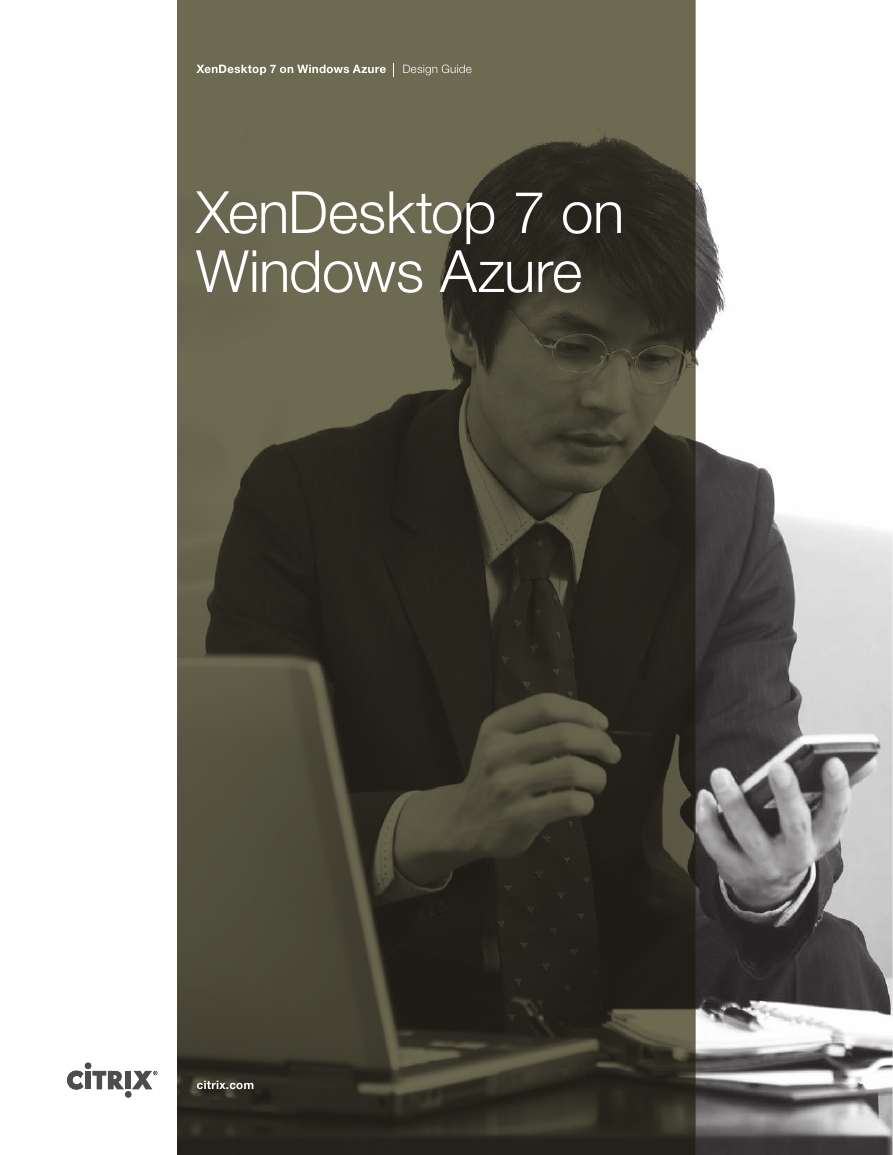
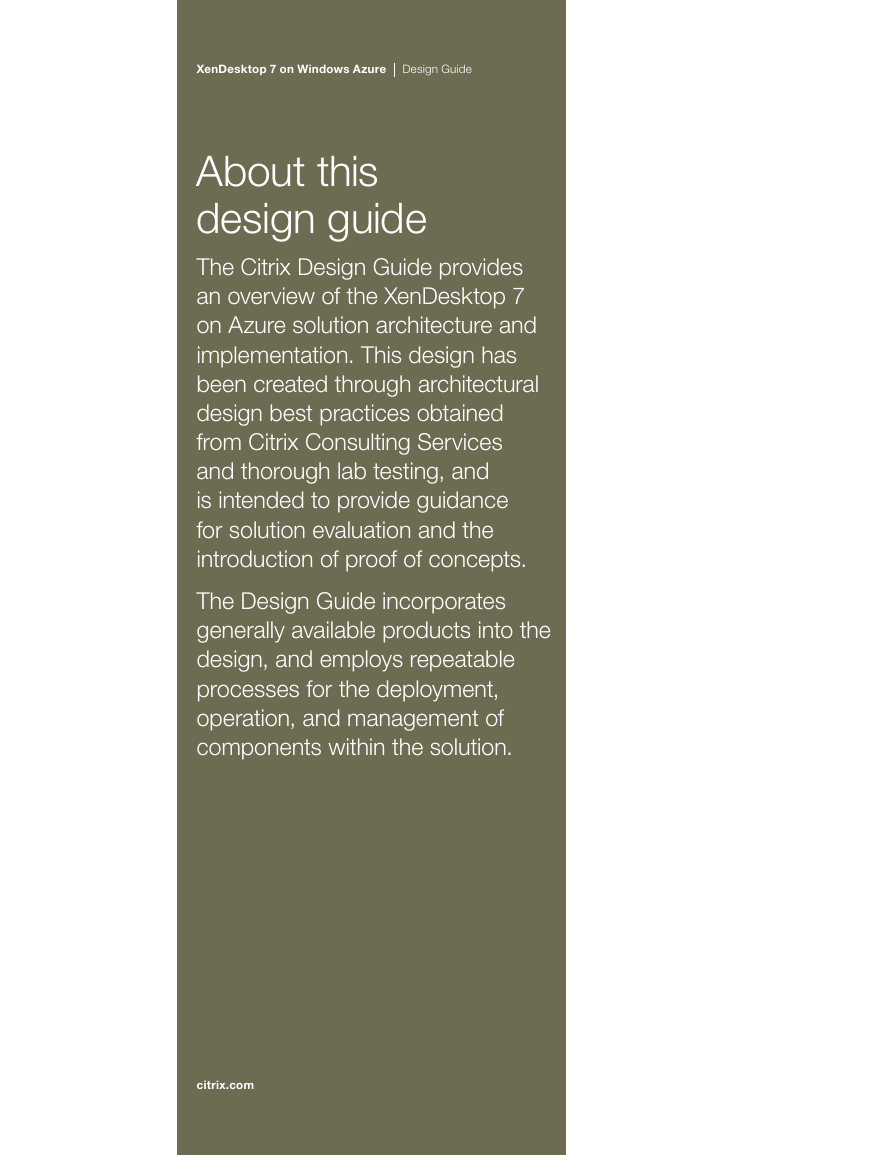
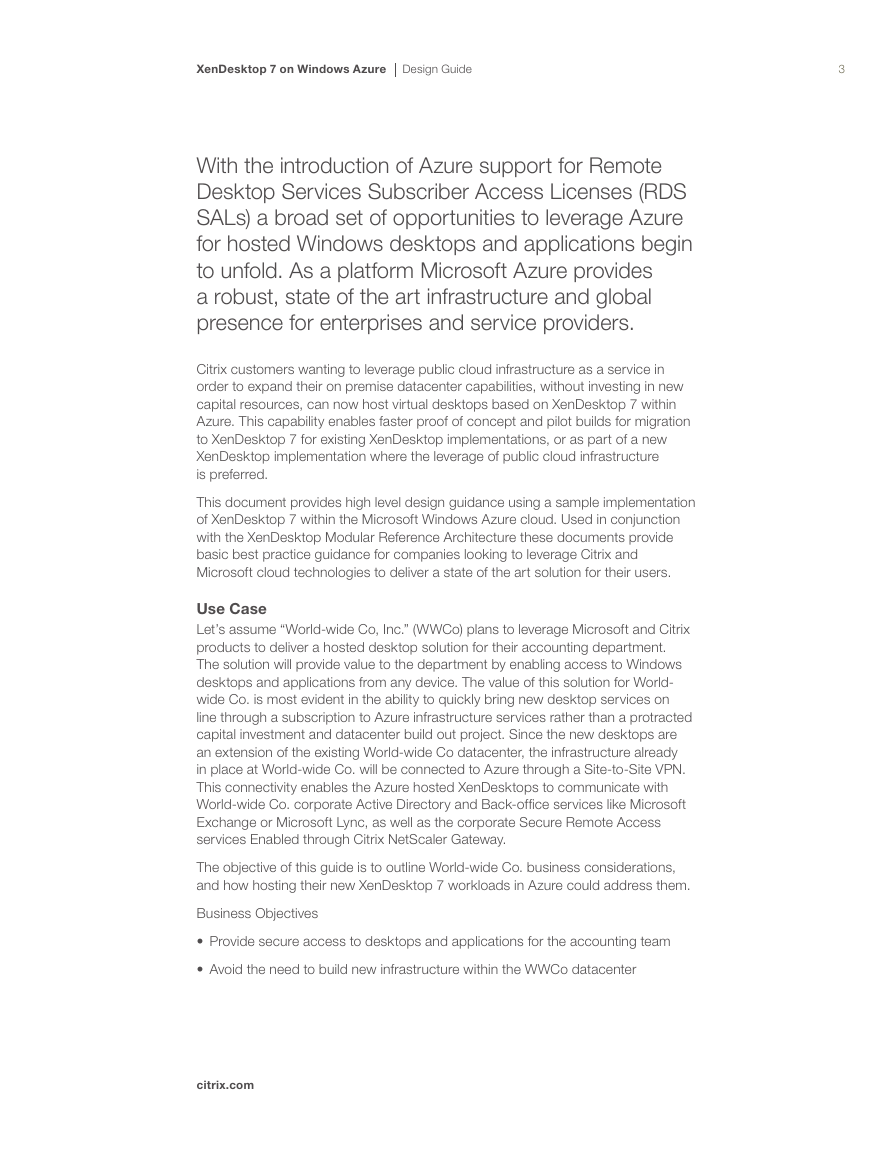

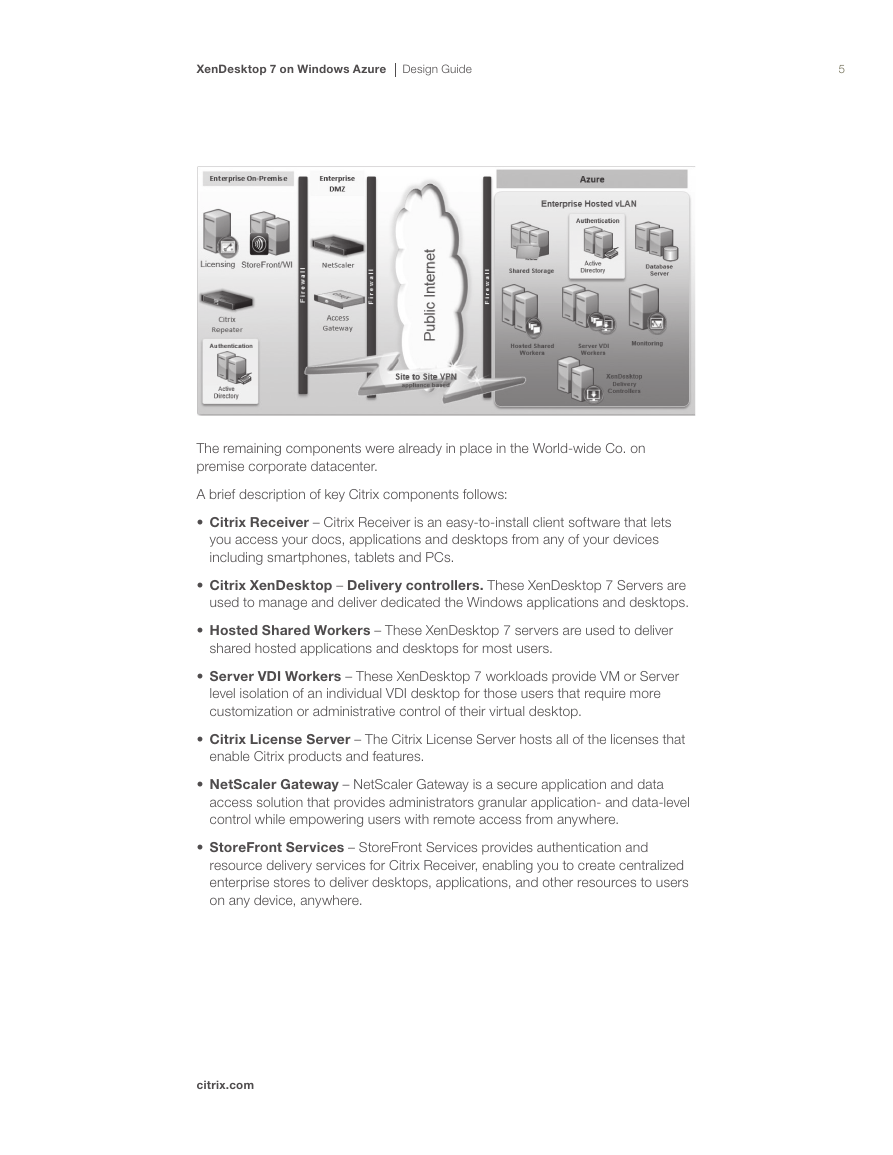
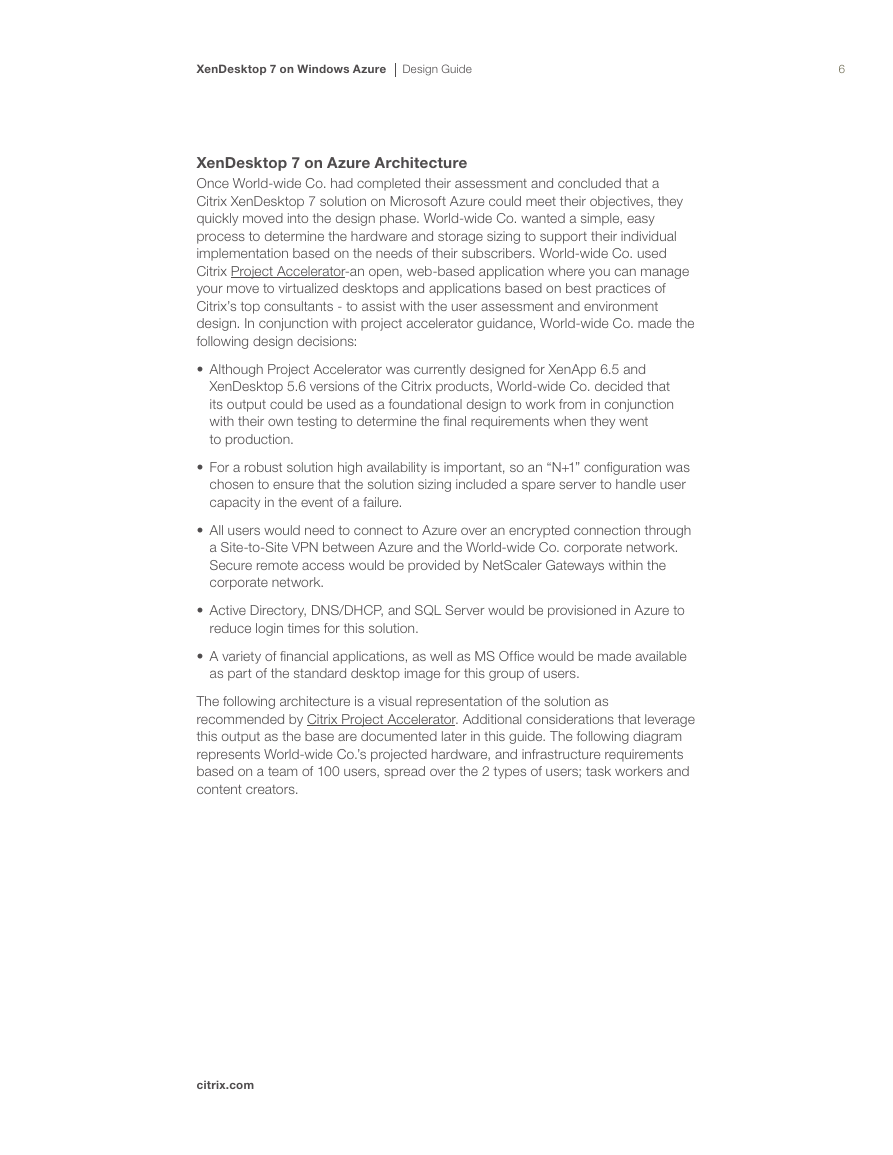
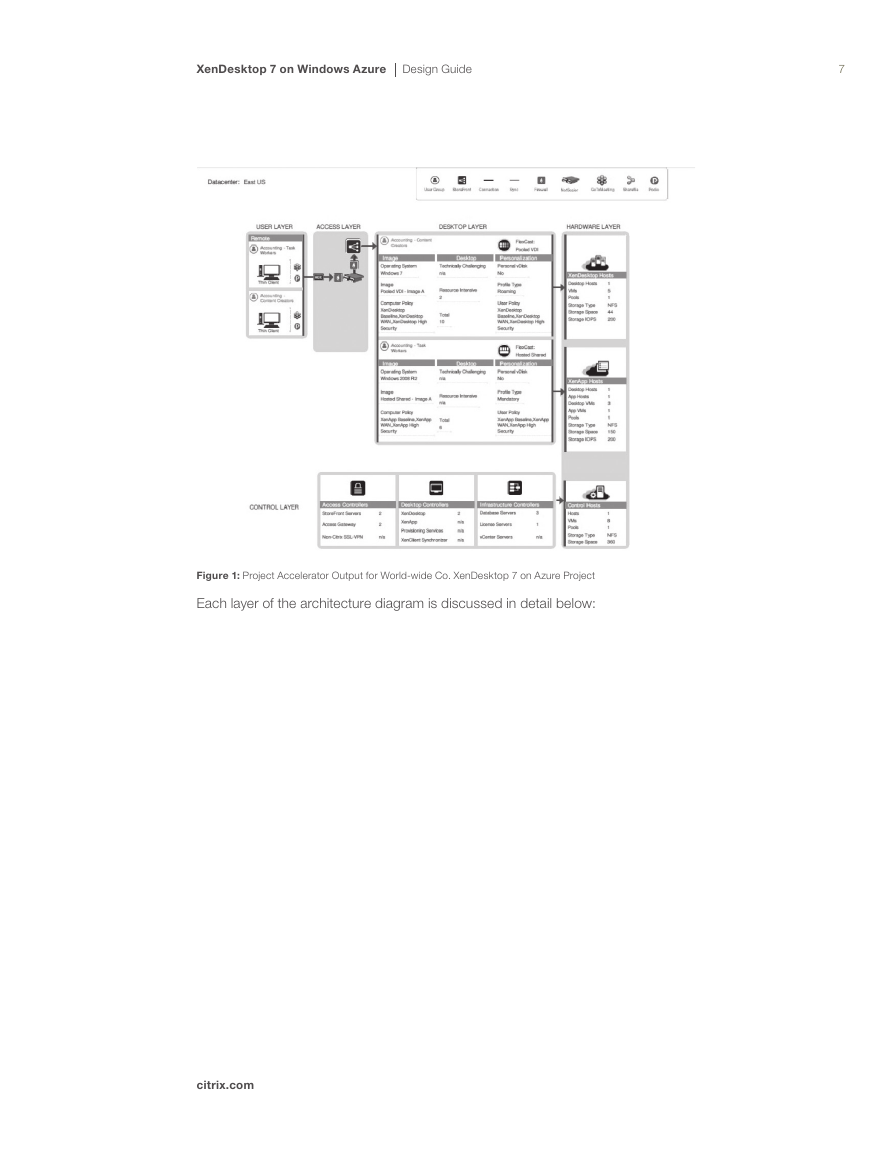
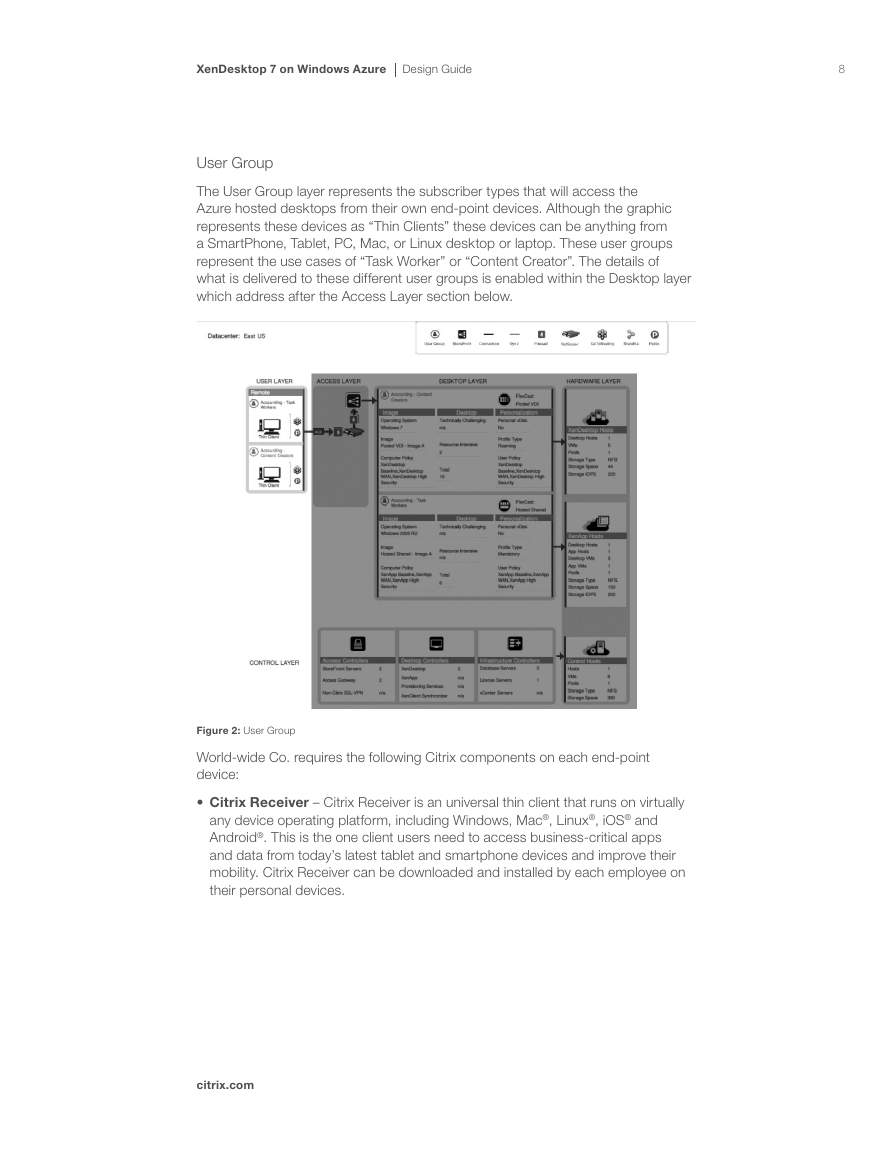








 2023年江西萍乡中考道德与法治真题及答案.doc
2023年江西萍乡中考道德与法治真题及答案.doc 2012年重庆南川中考生物真题及答案.doc
2012年重庆南川中考生物真题及答案.doc 2013年江西师范大学地理学综合及文艺理论基础考研真题.doc
2013年江西师范大学地理学综合及文艺理论基础考研真题.doc 2020年四川甘孜小升初语文真题及答案I卷.doc
2020年四川甘孜小升初语文真题及答案I卷.doc 2020年注册岩土工程师专业基础考试真题及答案.doc
2020年注册岩土工程师专业基础考试真题及答案.doc 2023-2024学年福建省厦门市九年级上学期数学月考试题及答案.doc
2023-2024学年福建省厦门市九年级上学期数学月考试题及答案.doc 2021-2022学年辽宁省沈阳市大东区九年级上学期语文期末试题及答案.doc
2021-2022学年辽宁省沈阳市大东区九年级上学期语文期末试题及答案.doc 2022-2023学年北京东城区初三第一学期物理期末试卷及答案.doc
2022-2023学年北京东城区初三第一学期物理期末试卷及答案.doc 2018上半年江西教师资格初中地理学科知识与教学能力真题及答案.doc
2018上半年江西教师资格初中地理学科知识与教学能力真题及答案.doc 2012年河北国家公务员申论考试真题及答案-省级.doc
2012年河北国家公务员申论考试真题及答案-省级.doc 2020-2021学年江苏省扬州市江都区邵樊片九年级上学期数学第一次质量检测试题及答案.doc
2020-2021学年江苏省扬州市江都区邵樊片九年级上学期数学第一次质量检测试题及答案.doc 2022下半年黑龙江教师资格证中学综合素质真题及答案.doc
2022下半年黑龙江教师资格证中学综合素质真题及答案.doc